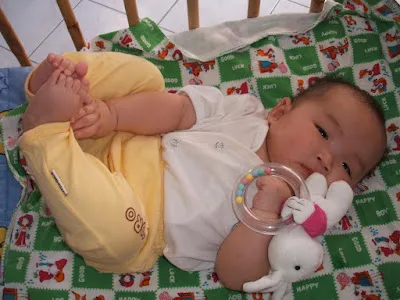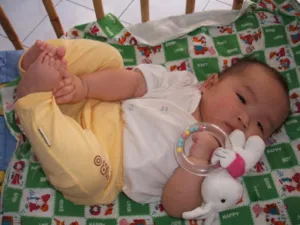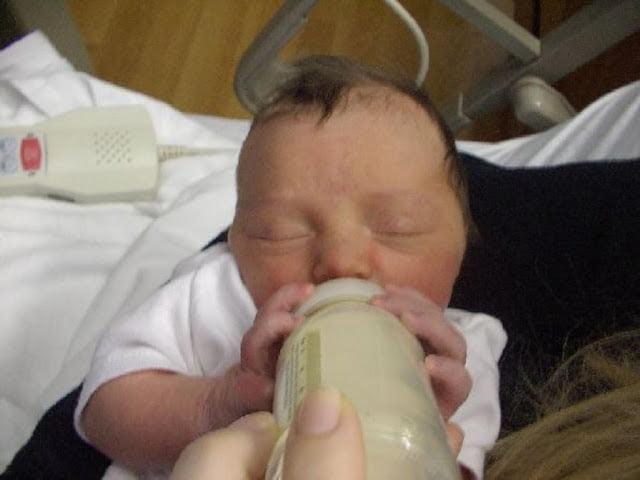Introduction
Language development in babies is a fascinating journey that not only shapes the way they communicate but also plays a crucial role in their cognitive, social, and emotional growth. In this article, we delve into the significance of baby talk, the various stages of language development, factors that influence it, and practical tips to encourage your little one’s linguistic progress. Lastly, we address common FAQs to help parents better understand this complex yet essential aspect of child development.

Definition of Baby Talk and its Importance
Baby talk, also known as infant-directed speech or motherese, is a unique way of speaking that adults naturally adopt when conversing with babies. It is characterized by a higher pitch, exaggerated intonation, and simplified vocabulary. Baby talk plays a pivotal role in capturing the infant’s attention, promoting bonding, and laying the foundation for language acquisition. By engaging in baby talk, parents inadvertently facilitate their child’s comprehension of speech patterns, rhythms, and the nuances of their native language.
The Stages of Language Development in Babies
Pre-linguistic Stage
The pre-linguistic stage encompasses the first year of a baby’s life. This phase is marked by various nonverbal communication forms, including crying, cooing, babbling, and gesturing. Initially, babies express their needs through crying but eventually progress to cooing, which consists of vowel-like sounds. Babbling emerges around six months of age, and infants begin to produce consonant-vowel combinations. Additionally, they learn to associate certain sounds with specific meanings, laying the groundwork for future language skills. Gestures also emerge as a significant means of communication, with actions like pointing and waving indicating the baby’s growing awareness of the world around them.
Holophrastic Stage
The holophrastic stage, typically occurring between 12 and 18 months, is characterized by the use of single words to convey entire thoughts or ideas. These words, or holophrases, enable babies to express their desires, observations, and emotions effectively. During this period, infants begin to understand the symbolic nature of language and recognize that words represent objects, actions, and concepts. The vocabulary in this stage is limited, yet each word carries substantial weight in the baby’s burgeoning communicative repertoire.
Two-Word Stage
Between 18 and 24 months, children enter the two-word stage, which is marked by the combination of words to create simple phrases. This milestone in language development demonstrates an understanding of basic syntax and the rules governing word order. Two-word utterances typically consist of a noun and a verb, such as “daddy go” or “eat cookie,” enabling the child to communicate more complex ideas. This stage highlights a significant leap in linguistic skills as toddlers transition from isolated words to meaningful, albeit rudimentary, phrases.
Telegraphic Stage
The telegraphic stage occurs between 24 and 30 months and is characterized by the production of multi-word sentences with a simple grammatical structure. Toddlers at this stage begin to use function words, such as articles and prepositions, albeit sparingly. The primary focus remains on content words that convey the core meaning of a sentence, hence the term “telegraphic.” For example, a child might say “Mommy give ball” instead of “Mommy, can you give me the ball?” Telegraphic speech represents the child’s ability to express more elaborate ideas while still developing a complete grasp of grammar.
Sentences and Beyond
By the age of three, children’s language skills evolve significantly, enabling them to form more complex sentences. They begin to master grammar rules, use function words more consistently, and demonstrate a rapidly expanding vocabulary. Pronouns, conjunctions, and other linguistic nuances gradually integrate into their speech, making it more adult-like. This period is marked by constant learning and refinement of language skills, as children absorb new words, phrases, and grammatical structures from their environment and daily interactions.
Factors That Affect Language Development
Nature vs. Nurture Debate
The nature versus nurture debate seeks to determine the extent to which genetics (nature) and environmental influences (nurture) impact language development. While genetic factors, such as innate language abilities and predispositions, play a significant role in shaping a child’s linguistic skills, environmental factors also contribute to this process. Studies have shown that rich language environments, characterized by stimulating conversations and exposure to diverse vocabulary, can significantly enhance a child’s language acquisition. Thus, both nature and nurture factors work in tandem to influence the development of linguistic abilities in children.
Parent-Child Interaction
Parent-child interactions are crucial in fostering language development. Engaging in meaningful conversations, asking open-ended questions, and offering constructive feedback can help children grasp language nuances more effectively. Furthermore, parents who model correct grammar, provide a diverse vocabulary, and maintain a supportive learning environment contribute significantly to their child’s linguistic progress. Active involvement in a child’s language journey not only strengthens the bond between parent and child but also sets the stage for successful communication in the future.
Bilingualism
Bilingualism, or the ability to speak two languages fluently, can have both positive and negative effects on language development. On the one hand, bilingual children may demonstrate enhanced cognitive abilities, better problem-solving skills, and increased cultural awareness. On the other hand, these children might experience a temporary delay in language milestones, such as vocabulary acquisition and grammatical development. However, research suggests that these delays are often short-lived, and bilingual children eventually catch up to their monolingual peers in terms of language development.
Hearing Impairment
Hearing impairment can significantly impact a child’s language development, as auditory input is crucial for learning the nuances of speech and communication. Children with hearing loss may experience delays in speech, vocabulary, and grammatical development. Early identification and intervention, including hearing aids, cochlear implants, and specialized therapy, can help mitigate these challenges and support a child’s linguistic growth.
Other Factors
Various other factors can affect language development, such as socioeconomic status, cultural background, and the presence of developmental disorders. Children from lower socioeconomic backgrounds may have limited access to language-rich environments and educational resources, which can hinder their linguistic progress. Moreover, cultural practices and beliefs surrounding language acquisition can also shape a child’s development. Lastly, developmental disorders, such as autism spectrum disorder or speech and language impairments, can impede a child’s ability to acquire and use language effectively.
Tips for Encouraging Language Development in Babies
Talk and Read to Your Baby
Engaging in conversation and reading to your baby from an early age can significantly boost their language skills. Narrate your daily activities, describe objects, and ask questions to stimulate their curiosity and understanding of the world. Reading exposes babies to new vocabulary, varied sentence structures, and diverse topics, enriching their linguistic repertoire and fostering a love for language.
Respond to Your Baby’s Cooing and Babbling
Responding to your baby’s cooing and babbling reinforces the importance of communication and encourages them to practice their budding language skills. By imitating their sounds and adding words to their vocalizations, you create a dialogue that fosters bonding and promotes linguistic development. Acknowledging your baby’s attempts at communication also helps them feel heard and understood, which is crucial for building a strong emotional connection.
Play Games with Sounds
Games that incorporate sounds and repetition can be both fun and educational for babies. Activities like peekaboo, pat-a-cake, and other sound-based games help children associate specific sounds with corresponding actions or objects, thereby enhancing their understanding of language. Additionally, these games provide opportunities for babies to practice their vocalizations and develop a sense of rhythm and cadence.
Sing Songs and Rhymes
Singing songs and reciting rhymes with your baby can be a delightful way to introduce them to the musicality of language. Lullabies, nursery rhymes, and playful tunes capture a child’s attention and expose them to new vocabulary, sentence structures, and cultural contexts. Moreover, singing can help establish a soothing routine and create cherished memories that strengthen the bond between parent and child.
Avoid Baby Talk
While baby talk can be beneficial in the early stages of language development, it is essential to gradually transition to adult-like speech as your child grows. Using proper grammar, complete sentences, and a diverse vocabulary exposes your child to the complexities of language, allowing them to learn from your example. Encourage your child to use correct pronunciation and grammar by gently correcting their errors and modeling appropriate speech.
Common FAQs Related to Baby Talk
- What are some signs of normal language development in babies?
Normal language development includes cooing and babbling during the first year, using single words by 12-18 months, forming two-word phrases by 18-24 months, and constructing simple sentences by 24-30 months. Children should demonstrate an expanding vocabulary and grasp of grammar as they grow. - How can I help my baby learn new words?
Engage in conversation, read books, sing songs, and expose your baby to diverse vocabulary and linguistic contexts. Encourage your child to practice their language skills by asking open-ended questions, offering constructive feedback, and modeling correct speech. - Is it okay to use baby talk with my little one?
Baby talk can be helpful during the early stages of language development; however, as your child matures, it is essential to transition to adult-like speech. This exposes them to proper grammar, sentence structures, and a richer vocabulary, ultimately supporting their linguistic growth. - How does exposure to different languages affect my baby’s language development?
Exposure to multiple languages can have both positive and negative effects. Bilingual children may develop enhanced cognitive abilities and cultural awareness but might experience temporary delays in language milestones. However, these delays are typically short-lived, and bilingual children eventually catch up to their monolingual peers. - What are some red flags for delayed language development in babies?
Red flags may include a lack of cooing or babbling by 12 months, no single words by 18 months, no two-word phrases by 24 months, and difficulties in understanding or producing speech beyond age-appropriate milestones. Consult a healthcare professional or speech-language pathologist if you have concerns about your child’s language development.
Conclusion
Language development in babies is a remarkable and complex process that lays the foundation for future communication, cognitive growth, and social-emotional well-being. Understanding the stages of language development, the factors that influence it, and the practical tips for promoting linguistic growth is crucial for parents and caregivers. By actively engaging with your child, providing a language-rich environment, and remaining vigilant for potential developmental concerns, you can support your baby’s journey towards effective and meaningful communication.








